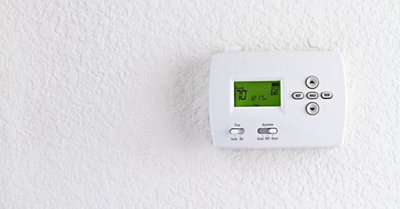Winter Programmable Thermostat Schedule for Maximum Savings

February 3, 2017
About one-third of U.S. homes have a programmable thermostat (according to a recent study). Unfortunately, most people don’t know how to use them properly. Most still rely on manual thermostats or manual operation of their programmable ones.
What Is a Programmable Thermostat?
A programmable thermostat allows you to pre-set the comfort conditions you need throughout the day. For example, you can set it to automatically turn down by 8 degrees every night before you go to bed.
A programmable thermostat, however, is only a tool. It doesn’t magically save you any money on heating or cooling. It takes strategic programming in order to save money. But a programmable thermostat will allow you to do that—if it is used.
How Much Money Can I Save?
Turning your thermostat back 10 degrees for an 8-hour period every day will save you a lot of money throughout the year. According to the U.S. Department of Energy, “by turning their thermostat back 10° to 15° for 8 hours, the family can save 5% to 15% a year on their heating bill — a savings of as much as 1% for each degree if the setback period is eight hours long.”
This translates to about $180 in savings every year. This assumes “a typical, single-family home with a 10-hour daytime setback of 8° F in winter and setup of 7° F in summer, and an 8-hour nighttime setback of 8° F in winter and a setup of 4° F in summer” (Energy Star).
Since all homes are different, you will probably experience more or less savings than the averages you see online. Regardless, thermostat setbacks definitely save you money, energy, and inconvenience. Some factors that make a huge difference in the savings you experience are:
- Correct HVAC sizing and installation
- Thermal mass and insulation levels
- Type of equipment (furnace, heat pump, etc.)
- Equipment maintenance and cleanings
- Proper thermostat programming
Another major factor that determines your savings is the type of climate you live in. Savings tend to be higher for buildings in milder climates compared with more severe climates.
For maximum energy savings, set your thermostat using the guidelines provided below and forget it. Don’t micromanage your thermostat.
Suggested Weekday Thermostat Schedule for Winter
Here’s a suggested thermostat schedule to maximize your savings during the fall and winter months:
- 6:00 a.m.: This is when the first family members are waking up to take on the day. The temperature in the home is 70°F or lower. The thermostat would turn on around 15-30 minutes earlier so it would reach this temperature by the time your feet hit the floor.
- 7:30 a.m.: The family and kids are leaving the house by this time. It’s recommended that you set your thermostat back at least 8°F. This would bring the temperature of the home to around 56-62°F while you are away from home. According to the U.S. DOE, “You can save as much as 10% a year on heating and cooling by simply turning your thermostat back 7°-10°F for 8 hours a day from its normal setting.”
- We recommend you never set the thermostat lower than 55°F. If you do, you could risk frozen pipes and damaging the property in your home. Don’t push it!
- 4:00 p.m.: Some family members start returning from work or school. The programmable thermostat knows this and turns on the heat around 15-30 minutes before the first arrival. At this point, the heat has brought the home’s temperature up to around 68°F.
- 10:00 p.m.: The family is getting ready for bed and the thermostat can help signal that it’s ready to hit the sack. If you have difficulty sleeping at night, turn the thermostat way down. We recommend setting it to 56-62°F, the same temperature you would if you were away from home. The lower temperature, combined with dimming lights and apps that get rid of computer blue light will help you get to sleep earlier.
- This schedule works for the weekdays, but you will most likely have different settings for the weekend when more people are at home.
Remember, you can save around as “1% for each degree if the setback period is eight hours long” (U.S. DOE). You will also save on your refrigeration costs by reducing the load on an appliance that is working hard to stay cold. And if you are on a diet and trying to lose weight, lowering the temperature of you home helps shed the pounds by increasing your energy expenditure to stay warm.
Suggested Vacation Setting
Don’t turn off your heating or cooling completely. Instead, ensure you have the proper humidity control and temperature by setting the thermostat to no lower than 55°F in the winter and no higher than 90°F in the summer.
If you have any questions about how to properly program your thermostat for maximum savings, don’t hesitate to give us a call. We also install programmable and smart thermostats, like NEST. Contact Service Champions to make sure your thermostat is compatible with your heating and cooling system.
Additional Resources for Programmable Thermostat Savings:
- ENERGY STAR® programmable thermostat tool
- ENERGY STAR® programmable thermostat guidelines
We’re here to help! If you have any comments or questions, we’d love to hear them.
Contact us today for trustworthy, on-time service in more than 120 cities across Northern California, including Sacramento, San Jose, East Bay, and South Bay.
